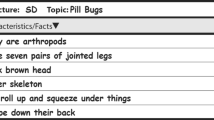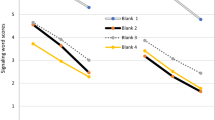Abstract
Research to guide text structure interventions for the primary grades is very limited, yet as early as in kindergarten, many state standards increasingly emphasize exposure to challenging expository texts. The purpose of the present study was to provide preliminary evidence of the feasibility and promise (or the effects) of three brief text structure interventions for kindergarten, first, and second graders who had average to low-average comprehension and relatively weak vocabulary skills. A total of 172 students participated (with 52, 62, and 58 in kindergarten, first and second grades, respectively). Students were randomly assigned within classrooms to one of three conditions: sequencing, compare and contrast, or cause and effect. Interventionists provided the interventions for four weeks to small groups of students. The findings demonstrated significant growth for all conditions on the taught text structure items of a researcher-made measure; significant growth was also reported on standardized measures of comprehension and oral language measures in the compare and contrast and cause and effect conditions, but not for sequencing.








Similar content being viewed by others
References
Cain, K., Oakhill, J. V., Barnes, M. A., & Bryant, P. E. (2001). Comprehension skill, inference-making ability, and the relation to knowledge. Memory and Cognition, 29, 850–859.
Ciullo, S., Lo, Y. L. S., Wanzek, J., & Reed, D. K. (2016). A synthesis of research on informational text reading interventions for elementary students with learning disabilities. Journal of Learning Disabilities, 49, 257–271.
Common Core State Standards Initiative. (2010). Common Core State Standards for English language arts & literacy in history/social studies, science, and technical subjects. Washington, DC: CCSSO & National Governors Association.
Connor, C. M., Phillips, B. M., Kaschack, M., Apel, K., Kim, Y.-S., Al Otaiba, S., et al. (2014). Comprehension tools for teachers: Reading for understanding from pre-kindergarten through fourth grade. Educational Psychology Review, 26(3), 379–401. doi:10.1007/s1064801492671.
Cromley, J. G., & Azevedo, R. (2007). Testing and refining the direct and inferential mediation model of reading comprehension. Journal of Educational Psychology, 99, 311–325.
Duke, N. K. (2000). 3.6 minutes per day: The scarcity of informational texts in first grade. Reading Research Quarterly, 35, 202–224. doi:10.1598/RRQ.35.2.1.
Englert, C. S., & Thomas, C. C. (1987). Sensitivity to text structure in reading and writing: A comparison between learning disabled and non-learning disabled students. Learning Disability Quarterly, 10, 93–105. doi:10.2307/1510216.
Gajria, M., Jitendra, A. K., Sood, S., & Sacks, G. (2007). Improving comprehension of expository text in students with LD: A research synthesis. Journal of Learning Disabilities, 40, 210–225. doi:10.1177/00222194070400030301.
Haager, D., & Vaughn, S. (2013). The Common Core State Standards and reading: Interpretations and implications for elementary students with learning disabilities. Learning Disabilities Research, 28, 5–16.
Hall, K. M., Sabey, B. L., & McClellan, M. (2005). Expository text comprehension: Helping primary-grade teachers use expository texts to full advantage. Reading Psychology, 26, 211–234. doi:10.1080/02702710590962550.
Hebert, M., Bohaty, J. J., Nelson, J. R., & Brown, J. A. (2016). The effects of text structure instruction on expository reading comprehension: A meta-analysis. Journal of Educational Psychology, 108, 609–629.
Kintsch, W. (1998). Comprehension: A paradigm for cognition. New York, NY: Cambridge University Press.
Lee, C. D., & Spratley, A. (2010). Reading in the discipline: The challenges of adolescent Corwin literacy. New York, NY: Carnegie Corporation of New York.
McNamara, D. S., Kintsch, E., Songer, N. B., & Kintsch, W. (1996). Are good texts always better? Interactions of text coherence, background knowledge, and levels of understanding in learning from text. Cognition and Instruction, 14, 1–43.
Mesmer, H. A., Cunningham, J. W., & Hiebert, E. H. (2012). Toward a theoretical model of primary-grade text complexity: Learning from the past, anticipating the future. Reading Research Quarterly, 47(3), 235–258.
Meyer, B. J. F. (1987). Following the author’s top-level organization: An important skill for reading comprehension. In R. J. Tierney, P. L. Anders, & J. Nichols Mitchell (Eds.), Understanding readers’ understanding: Theory and practice (pp. 59–76). Hillsdale, NJ: Erlbaum.
Meyer, B. J. F., & Poon, L. W. (2004). Effects of structure strategy training and signaling on recall of text. In Robert B. Ruddell & Norman J. Unrau (Eds.), Theoretical models and processes of reading (5th ed., pp. 810–851). Newark, Delaware: International Reading Association.
Meyer, B. J. F., Ray, M. N., & Middlemiss, W. (2012). Children’s use of comparative text signals: the relationship between age and comprehension ability. Discours, 10, 1–25. doi:10.4000/discours.8637. (En ligne).
Meyer, B. J. F., & Wijekumar, K. (2016). Intelligent tutoring of the structure strategy: A reading strategy tutor. In S. A. Crossley & D. S. McNamara (Eds.), Adaptive educational technologies for literacy instruction (pp. 82–103). New York, NY: Routledge Publishers.
Nation, K. (2005). Children’s reading comprehension difficulties. In M. J. Snowling & C. Hulme (Eds.), The science of reading: A handbook (pp. 248–266). Oxford, UK: Blackwell.
National Early Literacy Panel. (2008). Developing early literacy: Report of the national early literacy panel. Washington, DC: National Institute for Literacy and the National Center for Family Literacy.
NICHD National Reading Panel. (2000). National Institute of Child Health and Human Development, National Reading Panel report: Teaching children to read: An evidence-based assessment of the scientific research literature on reading and its implications for reading instruction. Washington, DC: U.S. Department of Health and Human Services, Public Health Service, National Institutes of Health, National Institute of Child Health and Human Development.
Raudenbush, S. W., & Bryk, A. S. (2002). Hierarchical linear models: Applications and data analysis methods (2nd ed.). Thousand Oaks, CA: Sage.
Reutzel, D. R., Smith, J. A., & Fawson, P. C. (2005). An evaluation of two approaches for teaching reading comprehension strategies in the primary years using science information/texts. Early Childhood Research Quarterly, 20(3), 276–305.
Shadish, W. R., Cooke, T. D., & Campbell, D. T. (2002). Experimental and quasi-experimental designs for generalized causal inference. Boston, MA: Houghton Mifflin.
Williams, J. P. (2005). Instruction in reading comprehension for primary grade students a focus on text structure. The Journal of Special Education, 39, 6–18. doi:10.1177/00224669050390010201.
Williams, J. P., Hall, K. M., Lauer, K. D., Stafford, K. B., DeSisto, L. A., & deCani, J. S. (2005). Expository text comprehension in the primary grade classroom. Journal of Educational Psychology, 97, 538–550. doi:10.1037/0022-0663.97.4.538.
Williams, J. P., Kao, J. C., Pao, L. S., Ordynans, J. G., Atkins, J. G., Cheng, R., et al. (2016). Close analysis of texts with structure (CATS): An intervention to teach reading comprehension to at-risk second graders. Journal of Educational Psychology, 108(8), 1061–1077. doi:10.1037/edu0000117.
Williams, J. P., Nubla-Kung, A. M., Pollini, S., Stafford, K., Williams, J. P., Nubla-Kung, A. M., et al. (2007). Teaching cause-effect text structure through social studies content to at-risk second graders. Journal of Learning Disabilities, 40, 111–120. doi:10.1177/00222194070400020201.
Woodcock, R. W., McGrew, K. S., & Mather, N. (2001). Woodcock–Johnson III Test of Achievement. Itasca, IL: Riverside Publishing.
Author information
Authors and Affiliations
Corresponding author
Ethics declarations
Funding
The research reported here was supported by the Institute of Education Sciences, U.S. Department of Education, through Grant R305F1000027 to Florida State University as part of the Reading for Understanding Research Initiative. The opinions expressed are those of the authors and do not represent views of the Institute or the U.S. Department of Education.
Rights and permissions
About this article
Cite this article
Al Otaiba, S., Connor, C.M. & Crowe, E. Promise and feasibility of teaching expository text structure: a primary grade pilot study. Read Writ 31, 1997–2015 (2018). https://doi.org/10.1007/s11145-017-9769-6
Published:
Issue Date:
DOI: https://doi.org/10.1007/s11145-017-9769-6




